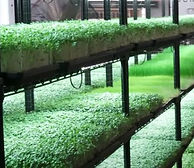
Smart Solutions in Protected Growing
CEHort is looking to the future of feeding people. The approach is to evaluate the plant-oriented nutritional needs of the population, then specialize in building the best model of plant cultivation, working outwards, given the cultivar species. The intent is to facilitate the construction, HVAC and backup systems, automated controls, and logistical cultivation design to optimize the plant and its environment, maximizing outputs. CEHort offers clients the best ways to use the innovations, resources, energy, and space economically, sustainably, and efficiently.
CEHort is beyond grateful to the post-secondary pilot projects being developed to optimize the human food supply so food insecure regions or nations, can become more secure.
Customized Production Optimization
Sustainable Design
The intent is to use math and science to identify the consumer, industry, and/or political need to construct the facility or work within an existing one. How feasible are the costs compared to the deliverables? How many employees will be needed adding to the operational costs? What are the resource and energy requirements for the size of the structure and cultivars to be cultivated? What environmental controls are required to manage the internal grow area? Is it a research facility for a post-secondary institution, a cultivation facility for school lunch programs, or a large-scale facility that feeds thousands of urbanites?

Efficient Construction
The traditional greenhouse can grow many plants but is incredibly inefficient considering the volume of space, materials, and climate. If looking to construct a turn-key facility, the CEHort design has been developed to satisfy the client's cultivation needs. The structure is built to the design plans and project specifications. Our approach in building a new facility is to incorporate as much below-ground technology and space using the earth as one of the best insulators. Any permits, zoning, and regulatory requirements are obtained. Subcontracted vendors will be sourced and vetted to build each component given their areas of expertise, following the approved plans. Evaluation in the design phase will isolate the areas of added expenses including back-up systems, primarily based on water, power, and internal operations.

Customization to Optimize
What are the variables to address for a cultivar species being grown in an indoor environment? Thermal losses, insulation, air intake and removals, fans, purification, movement, pressure, CO2, humidity, temperature. Irrigation design around the plants needs to optimize water use per zone(s). Optimized racking and media, inclusive of living soils. Plant size to optimize cultivation, including vertical mechanisms maximized per internal volume, operations and workflow, sensors and automation, back-up systems, safety, processing, harvesting, packaging, and produce ready for sale. This comprehensive approach will create an environment for the best possible deliverables.

How are you Growing Plants?

Grow Towers

Racking w Artificial Lighting

Large Scale Vertical Farming & CEA

Nature-based or Synthetic
How Feasible is that Growing?

Water Cost and Availability

Power Source and Costs

Cultivar Yields per Square Foot

Labor and Operational Costs
Food (In)Security
Food waste is over 30+% proving supply chain inefficiencies. Live, fresh produce travels long distances, "protected" using chemical amendments and processes to reach retailer shelves while losing flavor, freshness, and nutritional value. Research has identified the potential loss of up to 90% nutritional value along existing supply chains.
With today's innovations, technology, and resolve, there are ways to improve food production systems, especially in food-insecure cities, regions, states or nations.
CEHort is looking to introduce scalable, protected cultivation systems incorporating energy and resource-efficient technologies to feed more people, better.
%20-%20CERES%20Esoteric%20Logo%20Sample%202%20-%20LOGO%20ONLY%20(no%20words).jpg)

